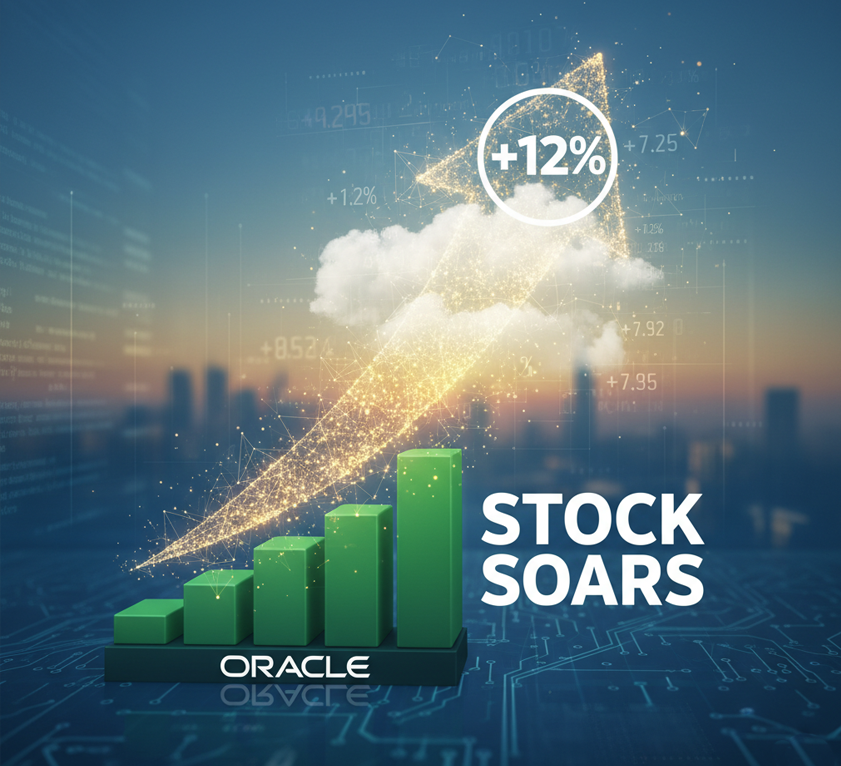Summary
For investors, Oracle’s recent earnings report and subsequent stock surge are significant as they reinforce the powerful market narrative that artificial intelligence is a durable and profitable driver of corporate growth. The company’s better-than-expected results and, more importantly, its strong future guidance, fueled by massive demand for its AI-focused cloud infrastructure, provided a tangible proof point that the AI boom extends beyond a few high-profile chipmakers. This news was a key catalyst in pushing major U.S. stock indices like the S&P 500 and Nasdaq to record highs, signaling that positive sentiment in the technology sector continues to lift the broader market. The event underscores how critical a company’s AI strategy and execution are to its market valuation today.
The Core News (What Happened?)
On Tuesday, September 9, 2025, Oracle Corp. (ORCL) released its fiscal first-quarter earnings report, which surpassed analyst expectations. The company also issued an exceptionally strong forecast for the upcoming quarter, citing massive growth in bookings for its cloud infrastructure services, driven by demand for training artificial intelligence models. As a result, Oracle’s stock price surged by more than 12% in the following trading session. This significant gain in a major technology firm contributed to a broad market rally, pushing both the S&P 500 and the Nasdaq Composite Index to close at all-time record highs on Wednesday, September 10, 2025.
Context & Expectations
Leading up to the earnings release, Wall Street analysts held cautiously optimistic expectations for Oracle. The consensus estimate was for the company to report adjusted earnings per share (EPS) a measure of a company’s profitability of approximately $1.21 on revenue of $14.0 billion. The primary focus for investors, however, was on the growth rate of its Oracle Cloud Infrastructure (OCI) unit and any commentary on its role in the booming AI industry.
Oracle’s actual results exceeded these expectations, delivering an adjusted EPS of $1.25 on revenue of $14.2 billion. Crucially, the company’s forecast for second-quarter revenue growth of 8% to 10% was significantly higher than the 7% growth that analysts had been modeling, providing a powerful upside surprise that electrified investors.
Potential Implications (The Bull vs. Bear Case)

Bull Case: Optimistic analysis, such as commentary from Morgan Stanley, suggests Oracle is successfully cementing its position as a critical “fourth major cloud provider” specifically for high-demand AI workloads. Bulls argue that multi-billion-dollar contracts to provide cloud infrastructure for companies like Microsoft and Google to train their large language models validate Oracle’s strategy and technology. This perspective sees Oracle’s recent performance not as a one-off event, but as the beginning of a sustained growth phase, capturing a significant share of the massive AI infrastructure market. This, in turn, fuels confidence in the entire technology sector’s earnings power.

Bear Case: Conversely, some analysts and market strategists, highlighted in reports from The Wall Street Journal, express caution. The bear case questions the sustainability of the current AI-driven market rally and points to stretched valuations across the tech sector. Skeptics worry that the market is displaying irrational exuberance, potentially overlooking broader macroeconomic risks like inflation or changes in interest rate policy. Specific to Oracle, concerns remain about the intense competition from established giants like Amazon Web Services (AWS), Microsoft Azure, and Google Cloud, who possess enormous scale and capital resources.
Key Data & Metrics
- Q1 Adjusted EPS: $1.25 (Expectation was $1.21)
- Q1 Revenue: $14.2 billion (Expectation was $14.0 billion)
- Q2 Revenue Growth Forecast: 8% to 10% (Expectation was ~7%)
- Oracle Stock Performance: Surged over 12% following the announcement.
- Market Indices: The S&P 500 and Nasdaq Composite both closed at new record highs on September 10, 2025.
Disclaimer: This article is for informational purposes only and does not constitute financial, investment, or legal advice. The information provided is a synthesis of publicly available data and expert analysis and should not be considered a recommendation to buy or sell any security. Investing in the stock market involves risk, including the possible loss of principal.5 Past performance is not indicative of future results. Readers should consult with a qualified financial advisor to determine an investment strategy that is suitable for their own personal financial situation and risk tolerance.






















